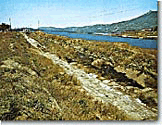


  |
|
Periander governed Corinth as a tyrant, from 627 until
The diolkos was constructed in the beginning of the 6th century BC, aiming to help and, undoubtedly, to draw profits by transporting merchandise via the Isthmus. The ships were no longer obliged to sail around Peloponnese travelling for three weeks under unfavourable conditions. The archaeological remains of the diolkos do not give information as to its exact role, for example whether the transport concerned traders or warships. Most likely though, it served both categories, since Thucydides mentions that the diolkos could be used in order to transport a trireme (Thucydides, Histories 3.15.1). |
 |
Practically, it was a wheel-driven trackway, which was used to transport ships across the Isthmus. First they used to unload the vessel and then they put it on the diolkos, in order to transport it. Small traders did not have to be unloaded. Probably in the process the diolkos fell into disuse, since the size of medium traders increased gradually.
This work was clearly more useful for the other Greek cities than it was for Corinth itself, since it already had ports in both sides of the Isthmus, namely Lechaeum and Cenchreae. Of course, in case of emergency Corinth would be able to reinforce quickly its fleet by transporting it from one bay to the other. And certainly its allies would find it useful for the quick and safe transportation of their products and their army.
|
| |
|
Note: Click on a picture for a brief description. | |